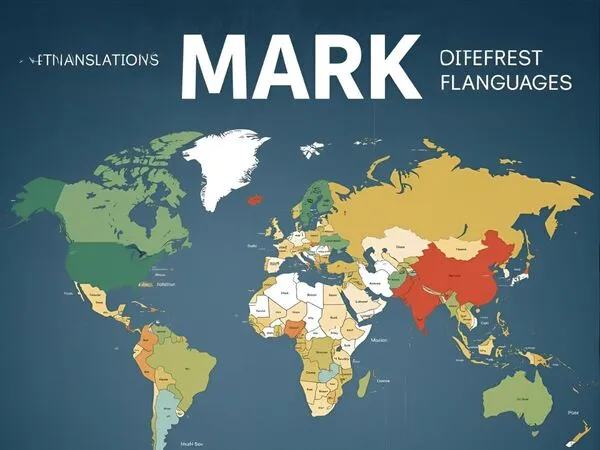You’ve probably landed on this page because you’re curious to know how to say “mark” in different languages. Maybe you’re learning a new language,
writing a multilingual story, traveling abroad, or simply expanding your vocabulary. Whatever the reason, you’re in the right place.
This article will solve your query by explaining the meaning of the word “mark”, showing you how it’s used in daily speech, and providing accurate translations in multiple languages. By the end, you’ll be equipped to use “mark” with confidence in various cultural and linguistic settings.
Mark in other languages

- “Mark” can be translated into various languages, often reflecting both a name and a word meaning “sign” or “symbol.”
- In Spanish, it’s “Marca” (for brand or sign) and “Marco” (as a name).
- In French, “Marque” means mark or brand, while “Marc” is the common name form.
- In German, “Mark” refers to a boundary or currency (like Deutsche Mark) and is also a given name.
- In Japanese, “マーク” (Māku) is the transliteration used for both the name and the word “mark.”
What Does the Word “Mark” Mean?

The word “mark” has several meanings in English depending on context. Here are the most common:
- Noun
- A symbol or line made on a surface (e.g., a pencil mark)
- A grade or score (e.g., a high mark in exams)
- A target or goal (e.g., aim for the mark)
- A visible sign (e.g., birthmark, scratch mark)
- A symbol or line made on a surface (e.g., a pencil mark)
- Verb
- To make a line or symbol (e.g., mark the spot)
- To grade or score something (e.g., the teacher marked the test)
- To indicate something (e.g., mark your calendar)
- To make noticeable (e.g., his behavior marked a change)
- To make a line or symbol (e.g., mark the spot)
Understanding this versatility will help you pick the right translation in other languages.
How to Use “Mark” in Sentences (Examples):

Here are a few sample sentences to show different uses:
- I got a good mark on my test.
- Please mark the correct answer.
- There’s a mark on the wall.
- She left a mark in history.
- He marked his calendar for the event.
Translations of “Mark” in 50 Different Languages

Below are translations of the noun “mark” (as in symbol or score) in various languages. Some languages may have different words based on context.
| Language | Translation | Pronunciation (if helpful) |
| Spanish | Marca | /ˈmaɾ.ka/ |
| French | Marque | /maʁk/ |
| German | Marke / Zeichen | /ˈmaʁ.kə/, /ˈtsaɪ̯çn̩/ |
| Italian | Segno / Marchio | /ˈseɲɲo/, /ˈmarkjo/ |
| Portuguese | Marca | /ˈmaʁ.kɐ/ |
| Russian | Метка (Metka) | /ˈmʲet.kə/ |
| Chinese (Mandarin) | 标记 (biāojì) | /pyāo-jì/ |
| Japanese | マーク (māku) | /maːku/ |
| Korean | 표시 (pyosi) | /pʰjo.ɕi/ |
| Arabic | علامة (‘alāmah) | /ʕaˈlaː.ma/ |
| Hindi | निशान (nishān) | /nɪˈʃɑːn/ |
| Urdu | نشان (nishān) | /nɪˈʃɑːn/ |
| Turkish | İşaret / Not | /iʃaˈɾet/, /not/ |
| Greek | Σημάδι (simádi) | /siˈmaði/ |
| Dutch | Merk / Teken | /mɛrk/, /ˈteː.kə(n)/ |
| Swedish | Märke | /ˈmær.kɛ/ |
| Danish | Mærke | /ˈmæɐ̯.kə/ |
| Norwegian | Merke | /ˈmær.kə/ |
| Polish | Znak | /znak/ |
| Czech | Značka | /ˈzna.t͡ʃka/ |
| Hungarian | Jel / Jegy | /jɛl/, /ˈjɛɟ/ |
| Finnish | Merkki | /ˈmerkːi/ |
| Romanian | Marcă | /ˈmarkə/ |
| Hebrew | סימן (siman) | /siˈman/ |
| Thai | เครื่องหมาย | /khrʉ̂ang-mǎai/ |
| Vietnamese | Dấu / Dấu hiệu | /zaʊ/, /zaʊ hiəw/ |
| Malay/Indonesian | Tanda | /ˈtan.da/ |
| Bengali | চিহ্ন (chihno) | /ˈtʃiʱno/ |
| Tamil | குறி (kuṟi) | /kuɾi/ |
| Telugu | గుర్తు (gurtu) | /guɾtu/ |
| Swahili | Alama | /aˈlama/ |
| Zulu | Uphawu | /uˈpʰa.wu/ |
| Afrikaans | Merk | /mɛrk/ |
| Ukrainian | Мітка (Mitka) | /ˈmit.kɑ/ |
| Serbian | Oznaka | /ˈɔzna.ka/ |
| Croatian | Oznaka | /ˈɔzna.ka/ |
| Bulgarian | Знак (znak) | /znak/ |
| Slovak | Značka | /ˈzna.t͡ʃka/ |
| Lithuanian | Ženklas | /ˈʒɛnk.las/ |
| Latvian | Zīme | /ˈziː.me/ |
| Estonian | Märk | /mærk/ |
| Icelandic | Merki | /ˈmɛr̥.cɪ/ |
| Filipino | Marka / Tanda | /ˈmarka/, /tanˈda/ |
| Nepali | चिन्ह (chinha) | /ˈt͡ʃinɦa/ |
| Persian (Farsi) | علامت (alamat) | /æˈlæː.mæt/ |
| Pashto | نښه (nakhah) | /naˈxɑ/ |
| Khmer | សញ្ញា (sânhnhéa) | /sɑɲˈɲiə/ |
| Lao | ໝາຍ (māi) | /māːi/ |
How This Helps You

Knowing how to say “mark” in different languages helps in:
- Multilingual communication
- Translation work
- Traveling
- Learning new languages
- Writing international stories, scripts, or documents
This resource can also be a handy reference for educators, students, translators, and content creators.
Conclusion
The word “mark” is simple yet powerful, and its many meanings allow it to appear across different conversations—from school exams to symbolic signs. With this list, you now know how to say “mark” in 50+ languages, understand its meaning, and can use it naturally in conversations around the world.



